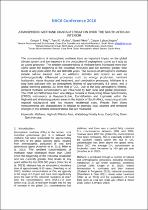JavaScript is disabled for your browser. Some features of this site may not work without it.
- ResearchSpace
- →
- Research Publications/Outputs
- →
- Conference Publications
- →
- View Item
| dc.contributor.author |
Feig, Gregor T

|
|
| dc.contributor.author |
Mudau, Tami E

|
|
| dc.contributor.author |
Piketh, S

|
|
| dc.contributor.author |
Labuschagne, C

|
|
| dc.date.accessioned | 2017-07-28T09:01:05Z | |
| dc.date.available | 2017-07-28T09:01:05Z | |
| dc.date.issued | 2016-10 | |
| dc.identifier.citation | Feig, G.T., Mudau, T.E., Piketh, S. et al. 2016. Atmospheric Methane characterisation over the South African interior. Proceedings of the 2016 Conference of the National Association for Clean Air (NACA), 5-7 October 2016, Nelspruit, South Africa | en_US |
| dc.identifier.isbn | 978-0-620-70646-9 | |
| dc.identifier.uri | http://www.naca.org.za/uploads/NACAProgramme_2016Final.pdf | |
| dc.identifier.uri | http://hdl.handle.net/10204/9329 | |
| dc.description | Proceedings of the 2016 Conference of the National Association for Clean Air (NACA), 5-7 October 2016, Nelspruit, South Africa | en_US |
| dc.description.abstract | The concentrations of atmospheric methane have an important impact on the global climate system and are important in the production of tropospheric ozone as it acts as an ozone precursor. The ambient concentrations of methane have increased more than 150% since the beginning of the industrial revolution and are currently greater than levels at any point within the last 800 000 years. The sources of atmospheric methane include natural sources such as wetlands, termites and oceans as well as anthropogenically influenced processes such as energy production, ruminant husbandry, waste disposal and treatment, and combustion processes. Methane is a long lived pollutant with an atmospheric lifetime of approximately 8.5 years, and a global warming potential 23 times that of CO(sub2). Due to the long atmospheric lifetime, ambient methane concentrations are influenced by both local and global processes. The CSIR and NWU have been operating a network of Cavity Ring Down Spectrometry (CRDS) instruments at Kwazamokuhle, Elandsfontein and Lephalale within the Highveld and Waterberg priority areas in the interior of South Africa, measuring at both regional background and low income residential sites. Results from these measurements are characterised in relation to potential local sources and temporal changes in the ambient concentrations that are measured. | en_US |
| dc.language.iso | en | en_US |
| dc.publisher | National Association for Clean Air (NACA) | en_US |
| dc.relation.ispartofseries | Worklist;18276 | |
| dc.subject | Atmospheric methane | en_US |
| dc.subject | Cavity Ring Down Spectrometry | en_US |
| dc.subject | CRDS | en_US |
| dc.title | Atmospheric Methane characterisation over the South African interior | en_US |
| dc.type | Conference Presentation | en_US |
| dc.identifier.apacitation | Feig, G. T., Mudau, T. E., Piketh, S., & Labuschagne, C. (2016). Atmospheric Methane characterisation over the South African interior. National Association for Clean Air (NACA). http://hdl.handle.net/10204/9329 | en_ZA |
| dc.identifier.chicagocitation | Feig, Gregor T, Tami E Mudau, S Piketh, and C Labuschagne. "Atmospheric Methane characterisation over the South African interior." (2016): http://hdl.handle.net/10204/9329 | en_ZA |
| dc.identifier.vancouvercitation | Feig GT, Mudau TE, Piketh S, Labuschagne C, Atmospheric Methane characterisation over the South African interior; National Association for Clean Air (NACA); 2016. http://hdl.handle.net/10204/9329 . | en_ZA |
| dc.identifier.ris | TY - Conference Presentation AU - Feig, Gregor T AU - Mudau, Tami E AU - Piketh, S AU - Labuschagne, C AB - The concentrations of atmospheric methane have an important impact on the global climate system and are important in the production of tropospheric ozone as it acts as an ozone precursor. The ambient concentrations of methane have increased more than 150% since the beginning of the industrial revolution and are currently greater than levels at any point within the last 800 000 years. The sources of atmospheric methane include natural sources such as wetlands, termites and oceans as well as anthropogenically influenced processes such as energy production, ruminant husbandry, waste disposal and treatment, and combustion processes. Methane is a long lived pollutant with an atmospheric lifetime of approximately 8.5 years, and a global warming potential 23 times that of CO(sub2). Due to the long atmospheric lifetime, ambient methane concentrations are influenced by both local and global processes. The CSIR and NWU have been operating a network of Cavity Ring Down Spectrometry (CRDS) instruments at Kwazamokuhle, Elandsfontein and Lephalale within the Highveld and Waterberg priority areas in the interior of South Africa, measuring at both regional background and low income residential sites. Results from these measurements are characterised in relation to potential local sources and temporal changes in the ambient concentrations that are measured. DA - 2016-10 DB - ResearchSpace DP - CSIR KW - Atmospheric methane KW - Cavity Ring Down Spectrometry KW - CRDS LK - https://researchspace.csir.co.za PY - 2016 SM - 978-0-620-70646-9 T1 - Atmospheric Methane characterisation over the South African interior TI - Atmospheric Methane characterisation over the South African interior UR - http://hdl.handle.net/10204/9329 ER - | en_ZA |






